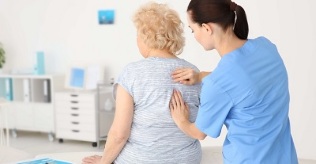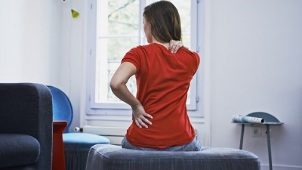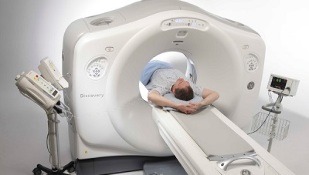
Breast fibroids are rare, but it can cause many complications. It is important to conduct a thorough diagnosis to make an accurate diagnosis. Treatment should be timely and comprehensive. Preventive measures will help prevent the development of such a disease.
Thoracic spinal tumor is a degenerative disorder in the cartilage structure. Without timely and competent treatment, osteonecrosis can cause a variety of complications that cannot be ignored. Precautions will help avoid such a pathology.
General characteristics of the disease
Bone tumor is a fairly common lesion of the musculoskeletal system, but it rarely affects the chest area compared to other parts of the spine. This is because this part of the spine is least mobile, so it is less stressful.
This feature is also a danger to the disease - its symptoms are less obvious, so the patient seeks to see severe bone necrosis.
This disease is characterized by the development of degenerative and dystrophic processes. They cause pathological changes that affect bone and cartilage tissue. If not treated, the pathology will change the structure of the ligaments, disc, and sheath and destroy them.
With the development of osteonecrosis, bone structures are affected first, then the pathological process spreads to the cartilage, muscle, and connective tissue structures. At a young age, such pathological changes cause the body to age prematurely.
Category
Pathology is characterized by gradual progression, therefore, there are four stages (degree), each of which is characterized by a number of clinical manifestations and complications:
- The early stage usually involves disc rupture, which can cause excessive stress or sudden movement.
- At the second stage, the protrusion of the disc is observed. In this case, the disc bulges into the disc tube - the protrusion usually does not exceed half a centimeter. At this stage, an instability of the spine develops.
- The third stage of bone necrosis is characterized by an increased intensity of clinical manifestations and is often accompanied by disc herniation.
- The fourth stage of the disease is called the most severe and dangerous. At this stage, osteogenesis cells appear. Their proliferation puts pressure on the spinal cord and nerve endings.
Reason
Bone tumors can develop at any age. The risk of it happening is not related to gender.
The disease usually develops on the basis of the following factors:
- age - people over the age of 40 are at risk;
- various pathologies of the spine, including curvature of the spine;
- genetic predisposition;
- trauma resulting in disc damage;
- chronic stress;
- hypothermia;
- hormonal imbalance, metabolism;
- impaired blood circulation in the thoracic region;
- features of occupational activity create an increased burden on the thoracic region.
Symptoms of necrosis of the thoracic spine
The disease can have different symptoms and sometimes manifest atypical. Usually, the pathology is manifested by the following signs:
- Pain. This symptom is main. Pain sensation usually arises when the body is in one position for a long time, exertion, lifting weights. As the pathology progresses, pain can also be observed at rest and intensified by any movement. She may feel dull or ache.
- Crush in middle of back panel. In this case, it is more difficult for a person to breathe. Painful sensation when breathing in or out deeply.
- Parts of the body became paralyzed.
- Chills and goosebumps may occur.
- Local temperature of the leg decreased.
- Itching and burning sensation may be felt in the lower extremities.
- If pathology affects the cardiovascular system, causing it to malfunction, this can be accompanied by peeling off the skin, thinning patches of nails and brittle nails.
- With the progression of bone necrosis, the work of organs in the gastrointestinal tract is interrupted, which can lead to a variety of symptoms: nausea, heartburn, flatulence, diarrhea, constipation, feeling of pain in the abdomen.

Pain is one of the main signs of osteonecrosis of the chest, but it can manifest itself in completely different ways. In some cases, back pain is observed - a painful sensation arises at the affected site and continues for a long time. In other cases, back pain occurs - intense and intense pain manifests itself, arises in episodes, muscle contraction and arrhythmia.
The clinical picture of osteonecrosis depends largely on its stage:
- In the early stages of the disease, rupture of the disc is often observed. This phenomenon is manifested by intense pain and muscle tension. These sensations are reminiscent of the action of an electric current, the discharge of an electric current appearing to travel along the spine.
- In the second stage, bulging eyes can be observed, accompanied by pain in the chest area, which can also affect internal organs.
- In the third stage of the pathology, pain appears more often. The patient becomes more difficult to breathe, the appearance of headaches. It can slightly disrupt the heart's work.
- In the fourth stage, due to compression of the nerve root, intercostal pain may develop. In this case, a throbbing pain occurs in the chest. At first, it only affects one area, but then spreads throughout the chest. This makes it difficult to breathe. The patient sometimes can not change the position of the body, the pain of intense movement many times, can not bear. Due to the severe pain, the pupils may dilate.
Symptoms of necrosis of the thoracic region are often increased at night, associated with being horizontal for a long time. After waking up, symptoms become less intense or go away completely, but sudden movements or low body temperature can increase them.
Atypical manifestations of thoracic necrosis include the following symptoms:
- Painful sensation in the heart area. This manifestation raises suspicion of heart attack or angina. Sometimes this symptom persists for several weeks.
- The pain is concentrated in the abdomen, leading to serious discomfort in the gastrointestinal tract. This symptom increases with physical activity.
- Severe pain in the upper abdomen. This symptom is characteristic of gastritis, pancreatitis, cholecystitis.
- In women, an exacerbation of the disease can cause pain that pulls the mammary glands. In this case, there are suspicions of a malignant tumor.
- Violation of genital organs.
- If pathological changes are concentrated in the upper chest area, then the pain can affect the esophagus or pharynx. Patients in this situation complain of a sensation of a foreign body in the throat.
Only a doctor can make a diagnosis. Bone tumors in the chest accompanied by many symptoms are also characteristic of other diseases. A qualified specialist will be able to understand all the nuances of the clinical scene.
Diagnosis
Doctor can make a preliminary diagnosis at the initial stage of patient examination. Usually a neurologist solves the problem of bone necrosis. The doctor examines the spine in different parts of the body.
To confirm the diagnosis and define the characteristics of the pathology, they use a diagnostic tool. The basic study is the X-ray.

In addition, the following measures can also be applied:
- computed tomography; Magnetic resonance imaging
- ;
- scattering;
- disc disc; Electromechanical
- .
They also use diagnostics in the lab. It may include general and biochemical blood and urine tests. Such studies are carried out for the purpose of differential diagnosis, to determine the characteristics of the pathology, associated complications.
Diagnosis is necessary not only to confirm the diagnosis, but also to distinguish osteonecrosis from other diseases. Given its atypical course of action, the clinical picture may resemble other pathologies that may not even be related to the thoracic region.
Treatment of necrosis of the thoracic spine
The disease requires complicated treatment. It not only involves the use of drugs, but also various methods of physical therapy, physical therapy exercises, massage.
During an exacerbation, bed rest is required. You should limit your movement as much as possible. Usually, the pain syndrome is so strong that the patient calls an ambulance. Treatment in this case is carried out in a hospital.
Limit movement during treatment. When there is no need to rest in bed, you can walk, but long walks are prohibited. Walking should be interspersed with rest. You should also not sit for a long time in one position.
As the disease progresses, they must use traction. This technique involves stretching the spine. This allows you to increase the distance between the vertebrae, decrease the size of the disc herniated mass, and activate the nutrition of the disc.
Drug treatment
Many drugs to treat necrosis of the breast are used to relieve pain, muscle tension and improve blood supply. For these purposes, the following drugs can be prescribed:
- The basis of drug therapy is often a nonsteroidal anti-inflammatory drug, which relieves pain and eliminates inflammation. These drugs are prescribed in the form of ointments and gels for external use, tablets and capsules for oral administration, solution for injection. Therapy may involve simultaneous administration of several drugs of the same class. The course of treatment usually lasts 1-2 weeks.
- For severe pain use glucocorticosteroids. Usually the drug is used for intramuscular injection or topical therapy.
- For severe pain, pain relievers are also used.
- In the case of unbearable pain, blockers are used. Blockade is carried out strictly according to indications in the hospital.
- Local irritants may help relieve pain. They can be based on natural ingredients - spicy chili extract, bee venom or snake.
- To restore blood circulation in the affected area, intramuscular injection of nicotinic acid is prescribed.
- Muscle relaxants are used to relieve muscle tension.
- After stopping exacerbations of the disease, drugs are often prescribed to activate metabolism, restore cartilage structure. This effect is provided by the chondroprotectors. These drugs include a course of treatment that lasts several months.
Only a doctor can prescribe essential medicine in a particular situation. It is necessary to determine the timing and schedule of each drug, taking into account the compatibility of different substances.
Physiotherapy and massage
In the case of thoracic necrosis, physiotherapy methods allow you to get rid of pain and restore mobility. The doctor can prescribe the following treatments:
- Electrophoresis
- or electrophoresis with drugs, including anti-inflammatory and analgesic drugs;
- magnetotherapy;
- darsonvalization; Paraffin wax application
- ;
- ozokeritotherapy;
- therapy; ultrasound
- ;
- mud therapy;
- UHF therapy.

Special attention should be paid to the treatment of bone necrosis in the chest. In the treatment of such a pathology, the following techniques can be performed:
- Classic.In this case, massage involves gently swiping, kneading, pinching, and rubbing. Such treatment should be of course. A course can consist of up to 15 sessions, each lasting no more than 20 minutes.
- Spot.The effect can be done on pain points or acupuncture points. The movement is performed with fingertips in a circle with increasing pressure.
- Boxed.The use of canned food allows you to create a vacuum, increasing blood circulation and lymphatic drainage. Squeeze massage increases muscle tone, eliminates pathological reflexes, accelerates microcirculation of various fluids in the body.
- Segment.This massage is done to improve blood supply to the affected area, stimulate the lymph drainage system and oxidize the tissues.
Gymnastics therapy
Physical therapy exercises are very effective in the case of bone necrosis in the chest. It should be done under the supervision of a specialist, but there are some exercises that can be done at home:
- Warm up before remedial exercises. To do this, you can take a shower and warm up a little. It includes waving, rotating, and turning.
- Lie on your stomach on the floor. Bring your hands behind your head, while keeping your elbows apart. Slowly lift your shoulders and body. Pull your right elbow first, then left. Perform 5 times.
- In the same starting position, put your hand behind your back and hook on the buckle. Perform a body bend, lifting your hands without opening it. At the extreme, you need to linger for a few seconds, gently return to the original position.
- Lie on the floor and put your hands behind your shoulders. Raise your shoulders in rotation, moving your head in the same direction.
- Lie on your stomach on a hard surface. Stretch your arms forward while lifting your body. Do a few repetitions, then do the same body lift, but the arms extend along the body.
- Sit on a chair and put both hands on the waist. Move the lever, gently lift and lower to the original position. At the extreme, you need to linger for a few seconds. Perform 5 times.
- It is recommended to do this exercise with a gym stick. It is necessary to sit down and raise your arm while inhaling, keeping a stick in it. When exhaling, return to starting position and lean forward.
- Lie on the floor and put your hand with the gym stick over your shoulder. Then tilt your body to the left and right. This exercise is contraindicated in scoliosis.
- Sit in a back chair, leaning on and bent back.
All exercises should be done smoothly and slowly. Sudden movements are excluded. If an exercise is painful, stop and take a little rest. If the pain is persistent, the exercise should be ended and consult a doctor.
Prognosis, complications
If detected in time and successfully treated for breast fibroids, the prognosis is good. If you don't pay attention to the disease, life expectancy will decrease by about 7%.
Progression of osteonecrosis may lead to the development of other pathologies:
- protrusion of a disc
- as it bulges into the spool tube; Disc herniation
- - unlike bulging eyes, it involves the rupture of annular fibers;
- disc stenosis, vertebral artery;
- pathology - a complex of symptoms that occurs when the roots of the spinal cord are damaged;
- kyphosis - commonly referred to as a humpback and implies curvature of the spine with the direction of the bulging dorsal part (sagittal plane);
- atherosclerosis of the lungs;
- shingles;
- malignant tumor;
- sexual dysfunction.
Precautions
Any disease is easier to prevent than to prevent and cure the pathological changes that have occurred.
Adhering to the following precautions will help prevent breast necrosis:
- Maintain a normal body weight.
- Moderate physical activity. Get regular exercise or at least daily exercise. It is imperative to include elements for back muscle strengthening in the exercise set.
- Avoid injury, physical overload.
- Maintain correct posture and, if necessary, make corrections.
- Avoid overwhelming emotions.
- Proper nutrition.
- Get rid of bad habits.
- Organize the right place to sleep. It is important to choose the correct mattress stiffness, aligning it with your individual characteristics.
- Streamline your workplace. If sedentary work, you should pay attention to a high backrest chair. Need to rest and warm up during that time.
- Timely medical examination.
- Treatment is complete and timely all diseases.
U of the thoracic spine can lead to various complications that negatively affect quality of life. At the first sign of the pathology, the doctor will diagnose and prescribe competent treatments. All regulations must be strictly adhered to.

























